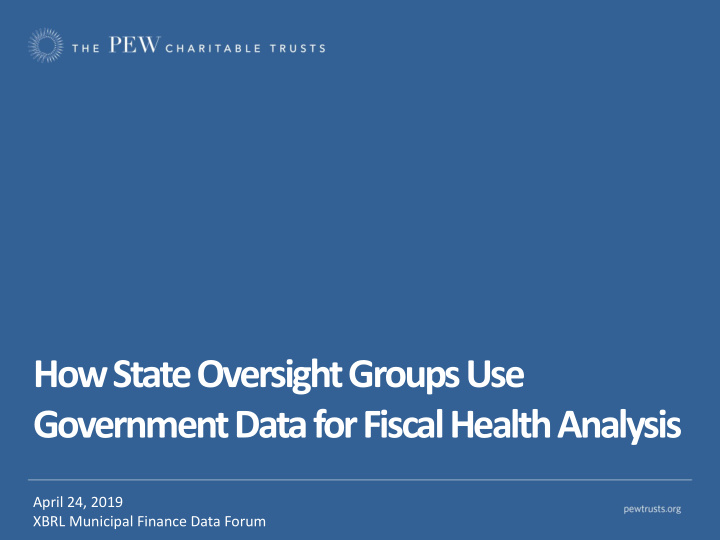



How State Oversight Groups Use Government Data for Fiscal Health Analysis April 24, 2019 XBRL Municipal Finance Data Forum
Who we are • The Pew Charitable Trusts is a nonprofit, nonpartisan research and advocacy organization working to improve public policy in a broad range of areas. • The state and local fiscal health team works on topics including rainy day funds, tax incentives, debt management, and fiscal monitoring.
State interventions
Fiscal monitoring
Fiscalmonitoring defined: • States that actively and regularly review financial information from local governments in order to assess the fiscal condition of local governments and/or identify signs of distress What we included: • General purpose local governments • Counties, cities, towns, and villages
Fiscal monitoring across the United States
Who is monitoring? • Auditor (FL, OH, WA) • Comptroller (NY) • Economic development (PA) • Finance (NM) • Legislative auditor (LA, MD) • Revenue/Taxation (RI, NV) • Treasury (MI, NC)
Sources of data • Audits • Financial reports • Budgets (proposed and adopted) • Also: estimated revenues, surveys of financial condition, five-year forecasts, cash analyses, and requests to issue debt
Financial indicators • Revenue • Debt • Expenditure • Unfunded liability • • Operating position Capital plant
Environmental indicators • Community needs and resources • Short-term shock • Intergovernmental constraint
Management practice indicators • Missed payments • Management issues • Credit ratings
Examples of indicators • Submitting audits or other financial information on time • Deficit or minimum fund balance • Debt service payments or debt service per capita or relative to operating revenue • Sufficient cash for services • Total revenue and/or expenditures per capita
More indicators • Unrestricted fund balance level/unassigned fund balance • Cash to liabilities ratio • Interfund transfers to supplement the general fund • General obligation debt/revenue or total debt per capita • Pension plan funding ratios
Some state updates • Virginia • Colorado • Ohio • Massachusetts
Data collection challenges • Data quality/standardization – Use third party datasets or checks by an auditor – Automation – Differences among local governments – Uniform chart of accounts – Cash vs. GAAP accounting • Resources (lack thereof) • Lags in data
Other considerations? • More indicators ≠ better • Fiscal dashboards not necessarily connected to fiscal monitoring/intervention • Who is the data intended for? – State – Local gov’ts – Public/researchers/journalists?
Conclusion • State governments are already collecting fiscal data from local governments • Data as a starting point for conversation • Fiscal monitoring, transparency, accountability
For additional information, please contact: Catherine An Officer, Communications Can@pewtrusts.org 202.552.2088
Recommend
More recommend